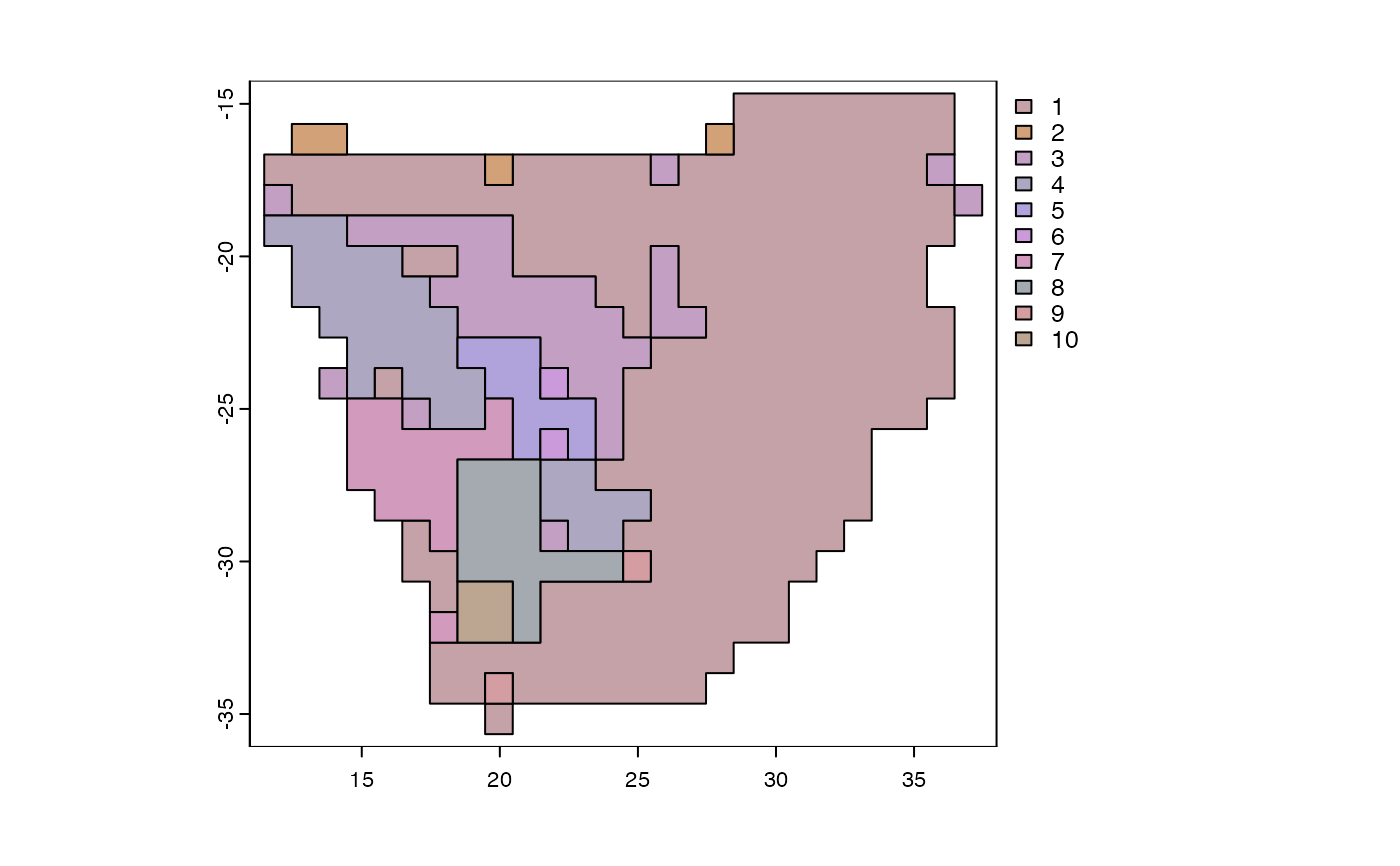Functional beta diversity for mixed-type functional traits
Source:R/functional_beta.R
functional_beta.RdComputes turnover of functional diversity using k-prototypes clustering algorithm tailored for mixed-type functional traits (numeric and categorical) to generate an integer vector of cluster assignments. The ranges of each species in a cluster are collapsed to generate a new community matrix based on the presence or absence of cluster membership in a grid cell. A grade of membership model or beta diversity is then fitted to the new reduced community matrix for further analysis.
functional_beta(
x,
trait = NULL,
bin = 10,
na.rm = "no",
quick_elbow = FALSE,
abundance = FALSE,
...
)Arguments
- x
A dataframe or sparse community matrix of species occurrences.
- trait
A data frame with the first column labeled “species” containing the taxonomic groups to be evaluated whereas the remaining columns contain the various functional traits. The variables should be mixed-type combining numeric and categorical variables.
- bin
The desired number of clusters or bins. If
elbow=TRUE, the optimal number of clusters is determined by running the analysis multiple times varying from 2 to bin.- na.rm
Logical, whether NA values should be removed prior to computation
- quick_elbow
Quickly estimate the 'elbow' of a scree plot to determine the optimal number of clusters.
- abundance
Logical, whether the reduced matrix should be returned as presence or absence of cluster representation or as abundances of cluster memberships
- ...
Further arguments passed to or from other methods.
Value
A list with three dissimilarity matrices capturing: (i) turnover (replacement), (ii) nestedness-resultant component, and (iii) total dissimilarity (i.e. the sum of both components).
For index.family="sorensen" the three matrices are:
beta.simA distance object, dissimilarity matrix accounting for spatial turnover (replacement), measured as Simpson pair-wise dissimilarity.beta.snedistobject, dissimilarity matrix accounting for nestedness-resultant dissimilarity, measured as the nestedness-fraction of Sorensen pair-wise dissimilaritybeta.sordistobject, dissimilarity matrix accounting for total dissimilarity, measured as Sorensen pair-wise dissimilarity (a monotonic transformation of beta diversity)
For index.family="jaccard" the three matrices are:
beta.jtuA distance object, dissimilarity matrix accounting for spatial turnover, measured as the turnover-fraction of Jaccard pair-wise dissimilaritybeta.jnedistobject, dissimilarity matrix accounting for nestedness-resultant dissimilarity, measured as the nestedness-fraction of Jaccard pair-wise dissimilaritybeta.jacdistobject, dissimilarity matrix accounting for beta diversity, measured as Jaccard pair-wise dissimilarity (a monotonic transformation of beta diversity)
References
Szepannek, G. (2018) clustMixType: User-friendly clustering of mixed-type data in R. The R Journal, 10: 200-208.
Examples
# \donttest{
library(terra)
data(africa)
p <- vect(system.file("ex/sa.json", package = "phyloregion"))
fb <- functional_beta(x=africa$comm, trait = africa$trait)
#> Assuming `range_size`, `habit`, `h_max`, `growth_duration`, `seed_size` as functional traits.
#> # NAs in variables:
#> habit growth_duration range_size h_max seed_size
#> 6 340 0 18 686
#> Estimated lambda: 488220.6
#>
p <- phyloregion(fb[[1]], pol = p)
#> Warning: convex combination of colors in polar coordinates (polarLUV) may not be appropriate
#> Warning: convex combination of colors in polar coordinates (polarLUV) may not be appropriate
plot(p)
 # }
# }